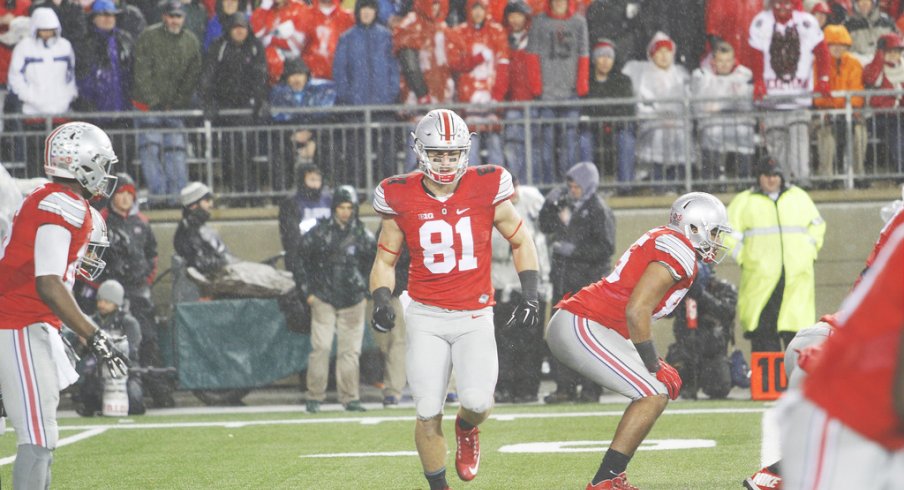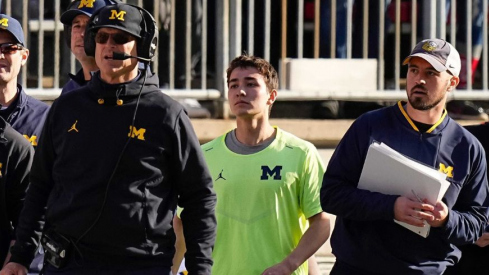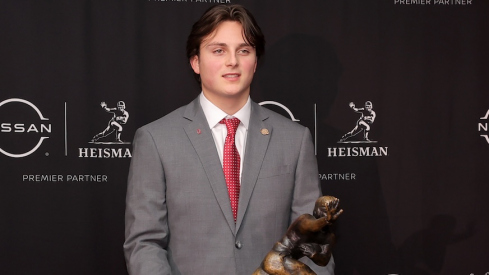"Just line up in the I-formation and run the dang ball behind a fullback!"
Such comments have been consistently found in the comments of Film Study columns since I began writing them three years ago. Despite witnessing production on the offensive side of the ball in that is unmatched school history, some readers of this space are still convinced that the missing element in Urban Meyer's offense has been the lack of a traditional I-formation running game.
It's hard to blame them. Maybe these readers witnessed three Heisman trophies make their way to Columbus thanks to this style of play - with the first two coming in Woody Hayes' final years and the last belonging to the bruising, downhill style of Eddie George. Plenty more readers probably have championship memorabilia from Jim Tressel's conservative 2002 campaign, the one where a freshman tailback ran all over the Big Ten behind a bruising offensive line and fullback.
To these fans of Ohio State football, Urban Meyer's spread-option attack may feel like a betrayal of Buckeye tradition, lining up in the shotgun on every play with three or four receivers. Even though the offense claims to be based on a power running game, there is no way that can be true if there's no bruising lead blocker in the backfield to clear the way for a workhorse ball-carrier, right?
In a word: no.
Though it's true Meyer built his offense around the base zone-blocking principles of Dennis Erickson's one-back offense (a system originally designed by a California high school coach named Jack Elway for his son, John, back in the 1970s), quite a few running game concepts found in the current OSU playbook were also in those of Meyer's predecessors.
While the foundation of Meyer's offense is the tight zone concept that can be run from virtually any alignment or personnel grouping, the versatility provided by his tight ends cannot be overstated. Though many have long pandered to see more passes head the way of Jake Stoneburner, Jeff Heuerman, Nick Vannett, or today, Marcus Baugh, each of those players proved to be crucial components in the Buckeye running game.
Long left alone next to the offensive tackles and only providing an extra gap at the end of the line, modern tight ends can be found split out wide, aligned in the slot, or even in the backfield in a 'Y-off' alignment just behind the tackle. This 'off' position allows them to easily motion to either side and flip the formation's strength at the last moment before the snap. However, it also creates an additional gap for which the defense must account, but this time doing so between the tackles - a role traditionally filled by a lead-blocking fullback.
This positional versatility has not only changed how the Buckeyes recruit, focusing on agile athletes capable of playing in space instead of just lining up an offensive lineman who could catch, but it's allowed 'spread' gurus like Meyer and new coordinator Kevin Wilson to incorporate more traditional '2-back' run concepts they used to run from the I-formation or pro-set.
The classic lead play (called 'isolation' or simply just 'iso' by many) can easily be ported over into the existing Buckeye playbook with the tight end in a 'Y-off' alignment to the same side as the runner. The offensive line doesn't have to learn anything new, though, as they're executing the same tight zone blocking they've run countless times before, while both the tight end (Y) and the back read the play-side guard to identify their gap.
One of the biggest misconceptions of modern, spread football is the idea that these new alignments brought all new plays with them. In reality, it's quite the contrary, as these three and four receiver shotgun looks simply provided window dressing for offenses to run the same plays they always had.
The addition of offensive players outside the hashes forces defenses to do the same, moving potential tacklers further from the ball in the run game. However, the run concepts seen today still utilize the same theories they always have.
One such example is the classic 'Power-O' concept that many Buckeye fans remember as 'Dave,' thanks to Jim Tressel. This concept overloads one side of the line with extra blockers, creating five potential gaps for the ball-carrier that must be defended.
In the traditional 2-back version, the fullback kicks out the defensive end while the backside guard pulls to lead the back through the hole. In the spread iteration, nothing changes except the alignment of the three players in the backfield, with the tight end filling the fullback's role.
In today's NFL, there are still countless QBs that simply turn around to hand the ball off and are removed from the play from that point on. Of course, one of the most important benefits of spread-to-run systems is the inclusion of the quarterback as a potential running threat.
The most common way the QB runs in spread systems is through the option game, as the offensive line simply leaves a defender completely unblocked as he's forced to account for this potential threat. But when a running threat like Braxton Miller or J.T. Barrett is taking the snap, old 2-back concepts, like the Washington Redskins' famous counter-trey, can easily be transformed with the quarterback also playing the role as lead ball-carrier.
But just because coaches continue to use the same concepts for four decades, it doesn't mean there hasn't been any innovation. As you might expect, these 2-back staples have been incorporated into the world of RPOs (Run-Pass Options), which allow pro-style QBs without running ability to do more than just hand the ball off.
As we saw in Ohio State's spring game, Meyer, Wilson, and the Buckeyes have incorporated that initial lead-zone play with a slant/flat pass route combination on the outside. Now, instead of reading the unblocked defensive end to potentially keep and run outside, the QB reads the alley defender (often an outside linebacker or safety) split out near the slot receiver.
By packaging the lead zone with a route combination instead of a basic screen or hitch, the QB effectively has three places to go with the ball - handoff to the back on the lead zone play, throw the flat route or hit the slant.
Such a play could not have been imagined were it not for the advancement of shotgun-spread football over the past two decades. Traditional, pro-style quarterbacks lined up under center simply aren't in a position to identify an optioned defender, given that their backs are turned to the line of scrimmage. Just imagine Elway, Joe Montana, Dan Marino, or any other signal-caller of the past 40 years in a system like this - able to use the defense's movements against them while still possessing the same physical, downhill running game with a tailback behind a physical lead blocker they've always had.
So next time you find yourself yelling at the TV to line up and run the ball, just look for the position of the tight end. There's a good chance Meyer and the Buckeyes are one step ahead of you.



